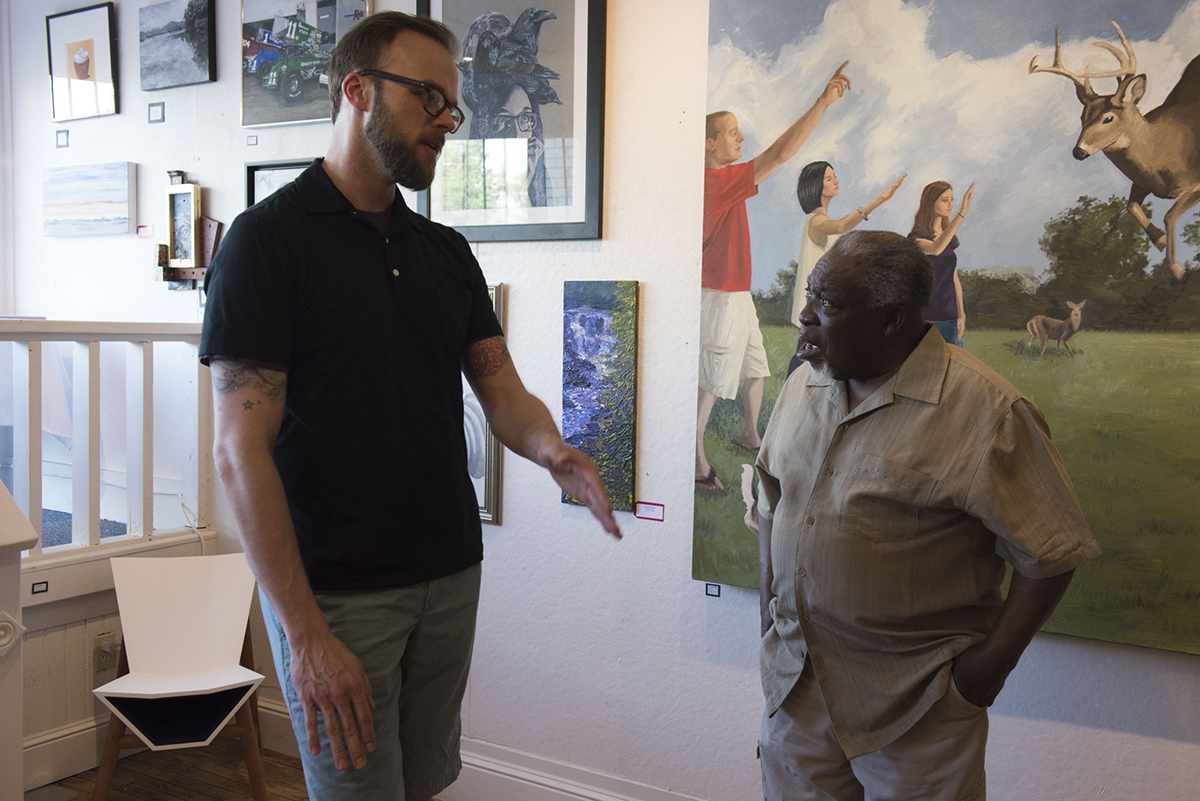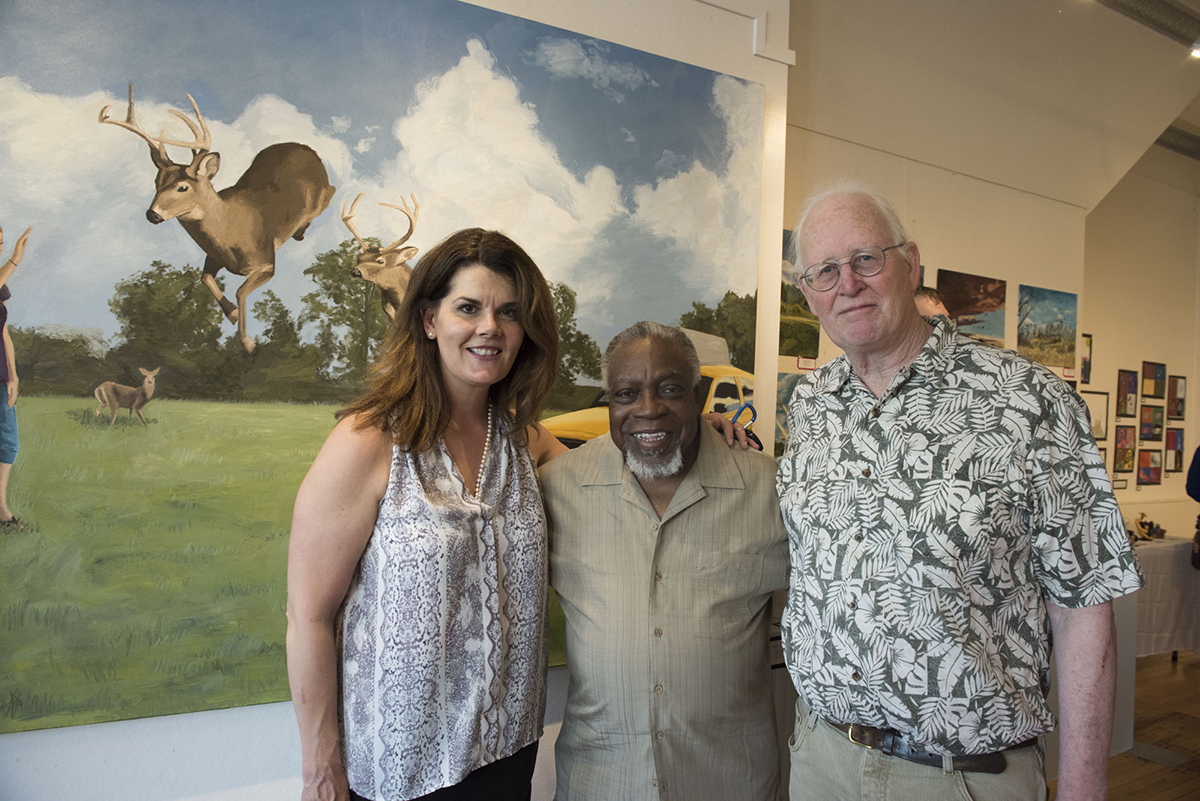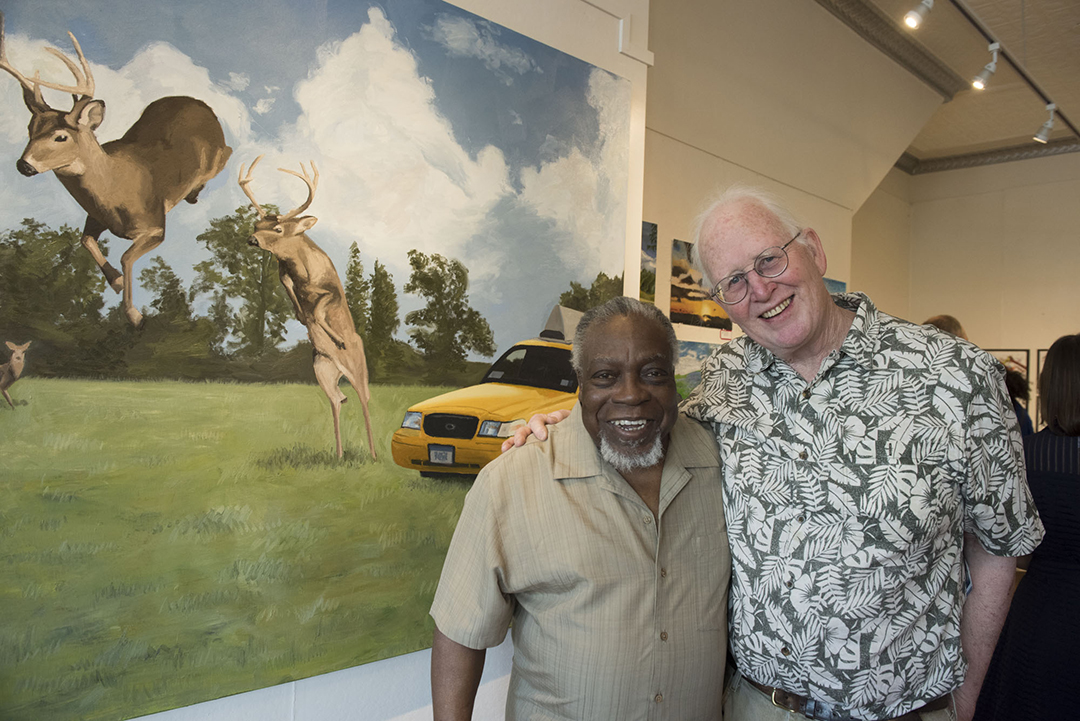Work of art: Sheppard’s teachings still making an impact 45 years in
Kaitlyn Dolan
Above: Luvon Sheppard, left, with former RIT MST in art education program director and professor Tom Lightfoot at the MST in art education program's capstone show last month. Joy Gallery, owned by Sheppard, housed the show.
Luvon Sheppard, after 45 years (and counting) of teaching in RIT’s College of Art and Design, is still growing.
Sheppard said he’s advanced as an artist, educator and a person through his interaction with students over the years. And his connection with those he teaches and has taught remains healthy and flourishing. That’s what keeps a successful, admirable career dedicated to a love for art and helping others discover their passion for it going strong.
“I’m at an age to retire, but I’m still excited, I’m still learning,” said Sheppard, who’s mainly been a professor in the School of Art during his time at RIT. “And the students seem to be excited. I think when they begin to be less excited about what I have to give them, then I will probably just end up retiring.”
For Sheppard, teaching is a two-way street. He believes in shared energy and lessons.
“I receive more than I give out as far as academic stimulation or conceptual awareness goes,” Sheppard said. “(The students) keep me abreast of what’s going on.
“Because of the students here at RIT I gleam a lot,” Sheppard added. “I don’t want to just teach illustrators, I don’t want to just teach painters or designers, I want to teach everybody. I want to be involved with the full circle of visual people. I think it gives me a much better peripheral as far as growing myself.”
•••
Sheppard, the 1986 RIT Eisenhart Award for Outstanding Teaching recipient, has crafted an enduring legacy that involves not only leading art and design classes at RIT. He’s also taught at SUNY Brockport, Geneseo and University of Rochester.
That’s not to mention his countless contributions to the vibrant arts community in Rochester, where he’s lived since he was 5 years old. And that he has paintings in permanent collections in the Rochester area, Boston and South Korea.
Sheppard has done his share to bolster the area arts scene. Under the auspices of University of Rochester’s Memorial Art Gallery in the 1970s, he started the Allofus Workshop, an organization that provided community art classes. Sheppard has also won countless awards and served on committees and boards related to the arts.
The well-versed Sheppard founded Joy Gallery in 2006, too. It was originally opened to attract art lovers and those not conversant with that area alike to a place where different groups could cross-pollinate, Sheppard said. The essence of the gallery is to encourage local talent and foster community pride.
Now situated at 498 1/2 West Main St. in downtown Rochester, Joy Gallery, in May, hosted RIT’s MST in art education program’s 2017 capstone show opening reception. It featured the work of this year’s four graduates and art created by the local K-12 students they student-taught.
Joy hosting the exhibit presented a full-circle moment for Sheppard, who was part of RIT’s first-ever MST in art education graduating class in 1970.
It was the second time Joy housed the year-end show.
“It’s an awesome space,” said Lauren Ramich, who’s worked in RIT’s MST program for 19 years and just completed her first as director. “It’s very community-based.”
Joy Gallery is just one example of Sheppard’s decades-spanning effort to promote local art.
“Luvon is a driving force in that neighborhood,” Ramich said. “People really respect him. He’s kind of like the Godfather of art.”

Ramich said Sheppard was present for the setup of last month’s opening, during it, and for the takedown, supporting and offering advice when asked.
Sheppard’s gentle, helpful guidance, Ramich said, are chief reasons why the one-year MST in art education program tends to recommend its graduate students to take Sheppard’s classes for electives.
In fact, Sheppard said he had two of this year’s MST candidates in a watercolor course and saw their responses to his teachings at the capstone display.
•••
Sheppard is quick to support the MST program because he holds it — and all it has done for him — in the highest regard.
It’s a mutual deference, too.
“I think every graduate student who takes his class will say to me at some point, ‘Wow. He is so wonderful. I can tell him and talk to him about anything,’” Ramich said. “He kind of nurtures and develops relationships. That’s the unique thing about Luvon — when he’s your professor, he’s so much more.”
Ramich would know. She had Sheppard as a professor for several classes at RIT en route to obtaining graphic design (BFA), painting and drawing (MFA) and art education (MST) degrees. She said “he was probably the most influential teacher I had at RIT.”
Additionally, Ramich said the MST program has called on Sheppard to help with accreditation processes and has him on its advisory council to offer his assistance and suggestions for changes.
“He’s definitely kind of still in that mentor role with us,” Ramich said. “He always has been.”
•••
The program has a clear respect for Sheppard and all that he has accomplished. But Sheppard can attribute many of his career exploits to his experience in that inaugural MST class.
Sheppard said he was one of two people on the receiving end of a national fellowship that enabled him to obtain free tuition and living expenses while completing the MST program.
The education he garnered during that one year made Sheppard complete, he said. According to Sheppard, the program equipped him with a range of skills and the right attitude that prepared him for the diverse professional route he ended up taking.
“There is a special thing that happens in that program,” Sheppard said. “The overall experience — academically and that on-the-job experience puts us into a very special place. It makes you a well-rounded professional.”
At one point, Sheppard stepped outside the realm of art and taught an African-American history course at SUNY Brockport.
“If I didn’t have that MST teaching background, I wouldn’t have been able to do that,” he said.

Sheppard said pursuing his master’s degree also enhanced his writing — which was advantageous considering he had to do an abundance of it after being hired by University of Rochester’s Memorial Art Gallery in 1970. Sheppard worked as the gallery’s coordinator of neighborhood affairs until 1976, using the opportunity to deeply impact the arts in Rochester, as well as himself.
He met and engaged with well-known artists — “These were people who were written about in history books,” Sheppard said — whose work was featured at the space.
The job also triggered Sheppard’s active leadership role in the local arts community that continues today, 40-plus years later.
While at Memorial Gallery, Sheppard started the Allofus Workshop, a pioneering program that acted as a neighborhood arts center. Classes in areas such as painting, drawing, ceramics, jewelry and printmaking were made available. It was one of the early examples of Sheppard stepping to the forefront to share his talents and appetite for art.
Sheppard, who earned a BFA in illustration degree from RIT, worked as both an educator and at Memorial Gallery for several years upon landing his first teaching gig at RIT in 1972. However, he eventually made the arduous choice to step away from Memorial Gallery, where he developed an intimate relationship with the art world, and commit more time to higher-education teaching.
“I did love the job at the Memorial Art Gallery,” Sheppard said. “It brought you closer to the art community.”
The chance to be a full-time professor at RIT aligned with Sheppard’s joining the MST program in the first place. Plus, it’s not like Sheppard wasn’t able remain in touch with the Rochester arts culture.
He found a way to blend all of his talents together beautifully, staying heavily active in both the community and classroom.
“I have students who I have been working with for over 40 years,” Sheppard said. “People who have been taking watercolor from me and we still go out and do plein air painting. And they teach. I taught them and they teach others. We still get together and teach each other.”
To Ramich, Sheppard is the same impactful figure today as he was when he taught her at RIT.
“He’s very powerful in a very quiet way,” Ramich said. “His power is quiet and unyielding, but it’s so substantial.”
In other words, he’s still growing.
“My personal growth is the thing that I kind of keep an eye on,” Sheppard said. “I get that from giving to the students, but also receiving from the students.”







